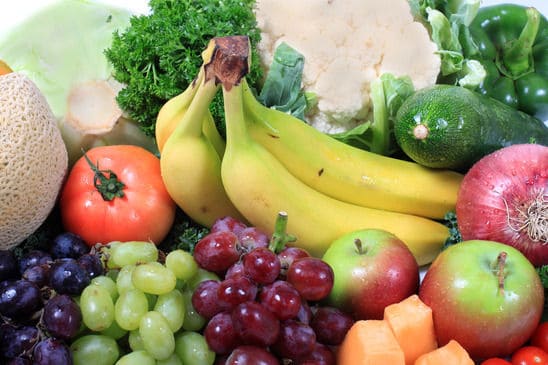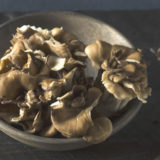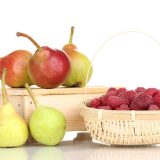

When you throw out your food because it has spoiled or you simply don’t want it, think again. When there is a small spot of mold, cheese that has hardened in one area, bruised fruit or pieces of a vegetable are brown – this doesn’t necessarily mean it is unhealthy to eat. Cut off the area and you’re safe to consume.
You’ll save money and throw out less when you buy whole, raw foods.
Storage Tips
- Keep fruits and veggies away from other foods stored in cans and boxes. They may contain chemicals that can leak into your produce.
- With most fruits and vegetables, make sure not to wash them unless you are going to use them at that time. Extra moisture can cause molding. You refrigerator should be cold, at least 40 degrees (F), or lower. Leave space and don’t over pack your fridge. Overstocking can cause less air to flow through, which will cause food to go bad faster. Freezing fruits and veggies is a great idea. They can last a few months and sometimes a year or more. Most should be cut and sealed up nicely.
For a longer shelf life, it depends on the specific fruit or vegetable that you are storing.
Tips for Fruits
- Keep bananas, apples and pears away from other fruits and vegetables because it will cause them all to spoil faster.
- Keep berries unwashed and in a container. Depending on the berry, the shelf life varies. Blueberries will stay in the fridge for about a week, strawberries are three days and raspberries are two days. Personally, I’ve had strawberries last about a week or more in their original container, unwashed.
- Cherries will last up to a week when refrigerated.
- Apples will keep on the counter for about a week.
- Melons can last up to five days on the counter, uncut. If cut it’s about three to four days.
- When refrigerated, citrus fruits can last up to three weeks. When at room temperature they can make it about a week.
- Keep peaches on the counter, away from sunlight. Putting them in a paper bag with holes will help them keep longer.
Tips for Veggies
- Take off or loosen the bands that hold vegetables together because it lets them breathe. Not washing veggies, unless you are using right away, will add three to four days to their life.
- Oxygen is not a friend of vegetables. Get as much air out of containers and bags before sealing, as it can double their shelf life.
- Cook veggies the way you want and save them in glass container in the freezer or fridge. They will last longer when frozen and retain more of their vitamins and nutrients.
- Spread tomatoes out on the counter.
- Wrap asparagus with damp paper towels around the bases or put upright in a glass with about an inch of water.
- Store onions in a cool, dark place, inside a mesh bag or stockings. If they get too cold or wet they will rot and if they become too hot they will sprout. Keep away from other produce because the smell of the onion will be absorbed. When peeled or chopped, in a container or bag, onions can keep up to a week.
- Avocados will last almost a month when refrigerated. When cut it is very short, a couple days, maybe.
- Lay potatoes on newspaper somewhere that it is dry and cool, like a drawer.
- Dry garlic bulbs should be kept at room temperature and not refrigerated. Make sure they are away from heat and light and they can last a few months. When peeled or chopped, they should be kept in an airtight container in the fridge.
Heat Shocking
A new way to keep both fruits and vegetables fresh longer may seem a little odd. It’s called “heat shocking” and it’s pretty simple and quick to do. It is not known exactly why heat shocking extends the shelf life of fruits and veggies – but it does help. It can slow the amount of time that something wilts, molds or browns. It also helps firm the skins.
Run your tap water until it is hot, but not very hot and fill a large pot about 2/3 of the way. The temperature should be between 105-140 degrees (F). Use a thermometer to check and, if it isn’t hot enough, briefly heat it on the stove. Hold the fruit or veggie in the water (the time varies depending on what it is), drain, dry and refrigerate.
Here are some of the foods and the length of time they should be kept in the water:
- lettuce for 1-2 minutes
- grapes for 8 minutes
- whole cantaloupe for an hour
- broccoli 7-8 minutes
- peaches for 40 minutes
You can find the times for other fruits and veggies on the Internet. And some call for a certain temperature, so look for that as well. You can do this with the foods listed and these others: strawberries, bean sprouts, carrots, potatoes, tomatoes, asparagus, green beans, celery and plums; and I’m sure there are more!
It’s so nice to come home with a bunch of fresh, colorful produce. But make sure you know what you’re going to eat and use in a planned meal. This will cause you to buy less and, in the long run, will mean throwing out less fruits and veggies. It will also save you money! If you know you’re going to have a busy week, then maybe you shouldn’t stock up on fruits and veggies. Fruits are a good idea because they are perfect as an on the go snack and can easily and quickly be packed in your lunch. Veggies are a little harder to deal with. They go great in meals like salads and stir-fried, but they’re not good on the go. Baby carrots and celery are the easiest to pack quickly with some dip or hummus. Make sure that if you are going to be very busy and not have that much time to make meals for yourself, set aside an hour or two to make some dishes and store them for later.
Go get some fresh fruits and veggies, store them up and enjoy for longer!




